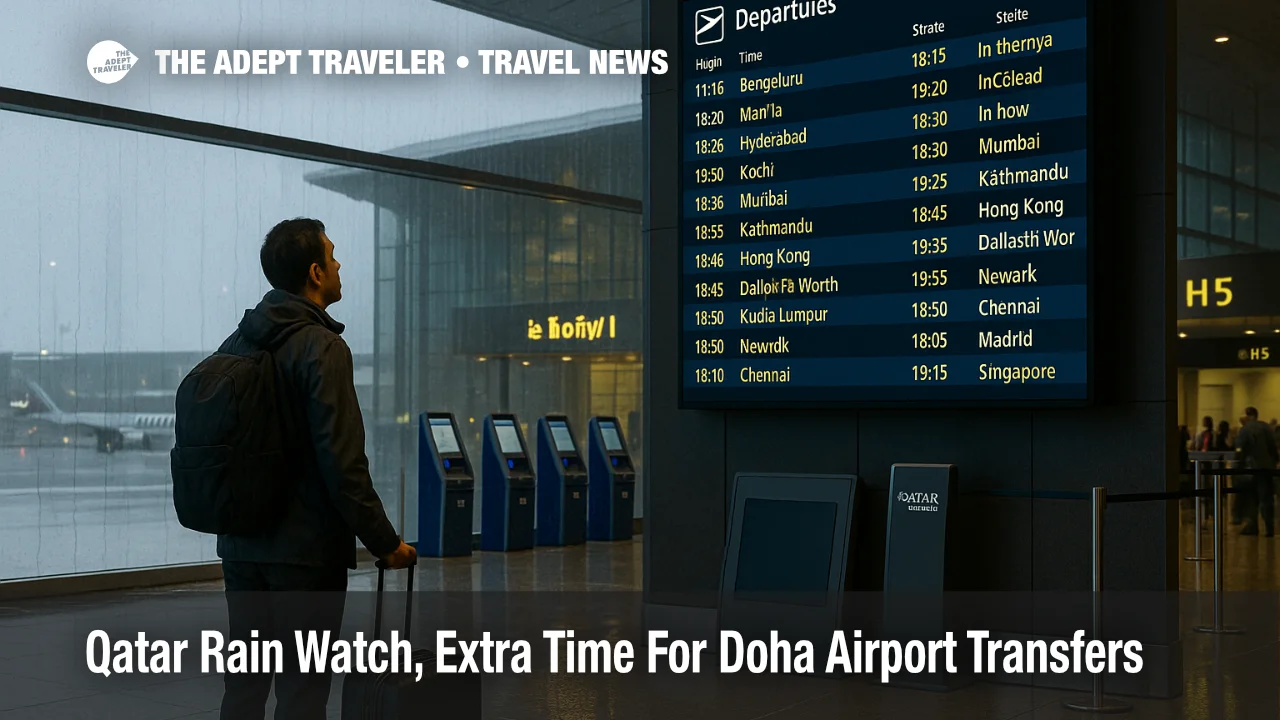Qatar Rain Watch, Extra Time For Doha Airport Transfers

Key points
- Qatar Meteorology Department signals periodic rain and isolated thunderstorms later this week
- Past showers have quickly ponded on Doha Corniche and low underpasses, which can slow airport access
- For Hamad International, consider Doha Metro Red Line to Terminal 1, or prebook taxis and ride hail from main arterials
- Monitor QMD updates daily and add buffer time during peak road periods
Impact
- Airport Access
- Allow extra time to reach Hamad International during rain, especially at peaks
- Best Routes
- Stage pickups on main arterials instead of local side streets near low spots
- Transit Options
- Prefer Doha Metro Red Line to Terminal 1 when road slowdowns develop
- Rideshare Tips
- Use designated HIA pickup areas and reserve ahead when heavy weather is forecast
- What To Watch
- Check QMD updates and MOI driving advisories as showers approach
Rain chances are building across Qatar later this week, with the Qatar Meteorology Department flagging periods of light to thundery showers around Doha. Even brief downpours can pool on low stretches of roadway and slow approaches to Hamad International Airport, Doha, Qatar. Travelers should plan extra time for peak periods, watch official daily forecasts, and consider rail or staged taxi pickups on the largest arterials to keep airport transfers moving. The core risk window aligns with midweek forecasts and could extend through the weekend if showers persist.
Qatar Meteorology Department outlook
Recent QMD daily reports have highlighted intermittent rain potential, including thundery cells in some areas. Peninsula summaries this month note showers and isolated thunderstorms on November 6, with ongoing mentions of rain chances into this week. Expect timing and intensity to vary by district, so the practical takeaway is to recheck the day's forecast each morning and again before departure.
Latest developments
Local outlets continue to carry QMD guidance that points to passing showers and localized thundery activity as the week progresses. Because convective showers can form quickly, short windows of heavier rain are the main operational concern for road approaches to the airport and for surface transfers across Doha.
Road pinch points and airport approaches
Short, intense bursts of rain have previously caused ponding and slowdowns along the Doha Corniche and at low underpasses and tunnel sections, which can ripple into airport access during peaks. Social and local media footage from prior events shows water collecting on Corniche segments and select low spots, illustrating how quickly conditions can change. When showers are active, keep to main arterials, leave larger following distances, and avoid attempting to pass through pooled water.
For Hamad International specifically, use the airport's designated drop off and pickup areas, and plan your route from broader corridors such as F Ring and E Ring connections rather than narrow feeders when rainfall begins. Reserve ride hail in advance, then follow the in-app wayfinding to the signed pickup locations to reduce curbside searching in wet conditions.
Getting to the terminal without the road hassle
When rain and traffic combine, Doha Metro can be the most predictable option. The Red Line runs directly to Hamad International Airport, Terminal 1, with frequent service seven days a week. Check the airport's Metro page for current service details, and confirm first and last train times before late-night departures. If you must use the bus, select routes that keep you on the largest corridors as long as possible and allow added time for wet-weather headways.
Background, how Gulf downpours behave
Gulf downpours tend to be short and intense, driven by convective cells that can overwhelm drainage at low points before clearing. The region has seen multiple recent episodes where brief heavy rain produced rapid pooling and traffic disruption. That pattern is why buffers matter on days with QMD thunder-shower language, even if the broader forecast reads mild.
Safety notes worth heeding
Qatar's Ministry of Interior regularly reminds drivers to slow down in rain, extend following distances, and avoid flooded lanes. After passing through pooled water, test brakes gently, and if visibility degrades, pull off safely until conditions improve. These measures are simple, but they meaningfully reduce minor collisions that compound congestion during showers.
Final thoughts
Qatar rain watch is a short-term advisory, not a shutdown scenario. Build buffers on Doha road approaches to the airport, use the Red Line when roads slow, and stage rides from primary arterials. Keep an eye on QMD updates, then adjust your plan by the hour if the rain bands intensify.
Sources
- Qatar weather: Thundery rain, strong winds expected today, cooler and cloudy weekend ahead
- Qatar weather: Relatively cold evening, chance of rain northeast offshore
- To and from the Airport, Hamad International Airport
- Metro to Hamad International Airport, HIA
- Doha Metro map, stations, timings, tickets, Nov 2025
- Uber, Hamad International Airport pickup and drop off
- Flooding along Doha Corniche, prior event footage, Doha News
- MOI Qatar, rainy-weather driving reminders
